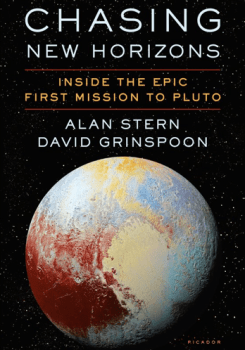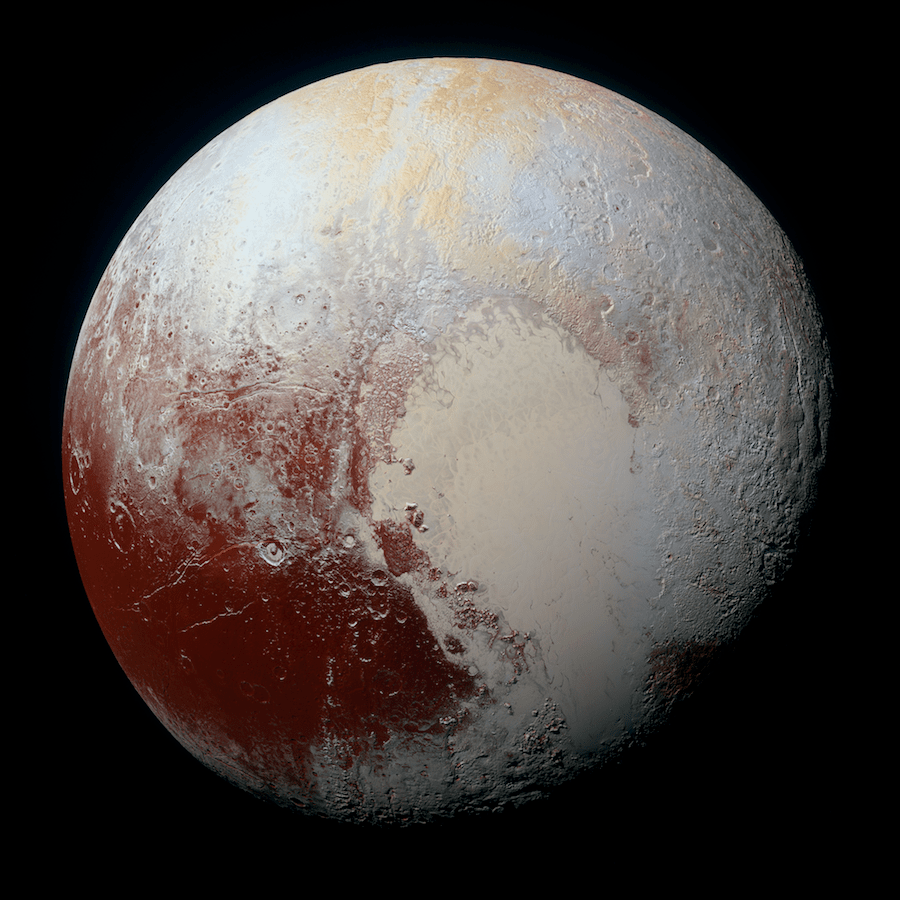On Pluto’s Doorstep
How did the New Horizons team wake up the spacecraft before it flew by Pluto? With a Star Trek theme song, of course.
The following is an excerpt from Chasing New Horizons: Inside the Epic First Mission to Pluto by Alan Stern and David Grinspoon.

Chasing New Horizons: Inside the Epic First Mission to Pluto
The crossing of Neptune’s orbit had been a milestone on Earth, but New Horizons slept right through it, gliding onward at its incredible speed in silent hibernation. Across the rest of 2014 too, New Horizons flew on in deep sleep, covering over 100 million more miles beyond Neptune’s orbit by the time that December had come.
Back on Earth though, its team wasn’t hibernating. Those months were a blur of final flyby simulations, planning for the expected onslaught of press and public attention, creating dozens of software tools to analyze soon-to-be-collected Pluto-system data, and the coding and testing of the early flyby approach sequences that would kick off almost as soon as 2015 did.
[Chasing Pluto, as long as it takes.]
On December 6, 2014, right on schedule, New Horizons commanded itself out of hibernation for the final time on its long cruise out to Pluto. The spacecraft was now barely six months from its flyby. Alan recalls:
Exiting hibernation for that last time meant showtime at Pluto was finally approaching. When we started hibernating back in 2007 after passing Jupiter, we found being in hibernation was pretty weird, because we’d been actively operating the spacecraft every day during the eighteen months since launch. It took us about a year to get comfortable and make hibernation routine. But by the time we got to 2014, we were so used to hibernation that it was like a warm blanket, and conversely the thought of living without it seemed weird.
After all, we really hadn’t operated the spacecraft day in and day out for more than a couple of months at a time in any given year since 2007. So the prospect of going back to that for all of the 2015 and 2016 flyby activities and the long downlink of data afterwards was a little daunting.
But most of all, exiting hibernation for the final time in 2014 felt momentous, because it meant that the only thing in front of us now was the flyby itself. No more years to go. It was a turning of a page: we had crossed the entire solar system. We really were on Pluto’s doorstep. 2014 was ending, and that surreal never-never year of 2015, which had been in our future for so long, was about to begin.
There was a gathering at the APL MOC to receive the signal from New Horizons, letting mission control know their bird had awakened for the flyby. NASA executives were there, along with a gaggle of reporters and camera crews. At the expected time, when the signal reached Earth—having traveled four hours at the speed of light from Pluto 3 billion miles away—Alice Bowman beamed and gave a thumbs-up. New Horizons was reporting in, ready for duty at Pluto! The room erupted in cheers; champagne, cake, and music ensued.
[Help astronomers identify gravitational lenses in a treasure trove of deep space imagery.]

There is a long tradition in space missions to mark milestone occasions with a “wake-up song.” That started all the way back in 1965 when the astronauts of Gemini 6 were woken up in flight with “Hello, Dolly!” and it continued across all the human spaceflights ever since. Somewhere in the 1990s, robotic missions began using music for milestone occasions, too. For the occasion of New Horizons emerging from its last hibernation en route to Pluto, Alan chose a piece called “Faith of the Heart,” an emotional theme song from the TV series Star Trek: Enterprise. Its lyrics seemed so appropriate to the journey of New Horizons. In fact, when Alan heard this song, to him it seemed to be telling the whole story of the mission.
The song begins “It’s been a long road, getting from there to here.” The poignant lyrics then tell a story about undertaking a long journey, overcoming adversity, and triumphing over opponents trying to hold you back, over many years, through having the perseverance to see your dream come true. But just how appropriate these lyrics were, the team members would not know until the following summer when they would discover the expansive heart-shaped feature that dominates the surface of Pluto. The song concludes with the lines ‘I can reach any star, I’ve got faith, faith of the heart.’”
“Waking the Bird” excerpted from Chasing New Horizons: Inside the Epic First Mission to Pluto, by Alan Stern and David Grinspoon. Published by Picador. Copyright © 2018 by Alan Stern and David Grinspoon. All rights reserved.
Alan Stern is Principal Investigator for NASA’s New Horizons mission, and a planetary scientist at the Southwest Research Institute. He’s also co-author of Chasing New Horizons: Inside the Epic First Mission to Pluto (Picador, 2018). He’s based in Boulder, Colorado.
David Grinspoon is an astrobiologist and a senior scientist at the Planetary Science Institute in Washington, DC. He’s also co-author of Chasing New Horizons: Inside the Epic First Mission to Pluto (Picador, 2018).